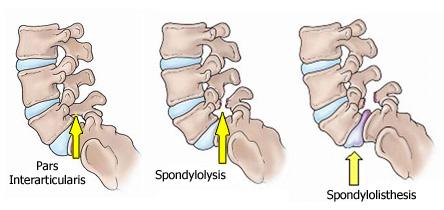What is Spondylolysis and Spondylolisthesis?
Spondylolysis is the medical term for a spine fracture or defect that occurs at the region of the pars interarticularis. The pars interarticularis is region between the facet joints of the spine, and more specifically the junction of the superior facet and the lamina.
When back pain severely interferes with normal life, the cause may be either Spondylolysis or Spondylolisthesis. Although they may sound similar, one is actually a more advanced version of the other. These conditions are caused by the spinal bones (vertebrae) moving out of their proper alignment, often resulting from a fracture. Spondylolysis is defined as a stress fracture in the bones of the spinal column while spondylolisthesis is a stress fracture that weakens bones so they are unable to maintain their proper position, resulting in shifting. The leading destination for diagnosis and treatment for spondylolysis and spondylolisthesis is Georgia Clinic of Chiropractic (Augusta, GA).

What causes this problem?
Spondylolysis is thought to be caused by repeated strains that damage the lower spine over time. The repeated strains can eventually lead to an overuse injury in the pars interarticularis. The most common location for this to occur is in the lowest vertebra of the spine, which doctors call L5. This vertebra connects the spine to the pelvis. However, a problem with the pars can occur in any lumbar vertebra. It rarely happens in more than one vertebra at a time.
The vertebra initially responds to the abnormal strain by adding new bone cells around the injured area. But if the injuries happen faster than the body can keep up with needed repairs, a crack may form in the weakened bone. This is called a stress fracture. This type of fracture occurs in the pars, the area of bony ring between the pedicle and lamina.
The crack may affect only one side of the bony ring. However, it is equally common for the defect to occur on both sides. When this happens, the vertebra is no longer held firmly in place by the facet joints on the back of the ring. As a result, the vertebra is free to slip forward over the one below. This slippage, which is closely related to spondylolysis, is called spondylolisthesis.
What are the symptoms of spondylolysis and spondylolisthesis?
Most people with spondylolysis or spondylolisthesis are asymptomatic and are unaware they have the condition. When symptoms are present, however, they may include:
- Low back pain
- Feeling of “hamstring tightness”�
- Pain radiating down the legs
- Difficulty with upright posture and gait
What is an effective form of treatment that doesn’t involve surgery?
Chiropractors are trained in treating musculoskeletal and neurological problems without drugs or surgery. Specialized and advanced chiropractic treatments for Spondylolysis and Spondylolisthesis have been developed over the years and have great success in both relieving symptoms and providing greater stability. We have helped countless patients at Georgia Clinic of Chiropractic with Spondylolysis and Spondylolisthesis, offering a great alternative that doesn’t involve the risks associated with surgery. If you or someone you know is suffering from Spondylolysis and Spondylolisthesis, you can call our office today to schedule a complimentary consultation to see if our treatments are the right fit your specific situation.
Georgia Clinic of Chiropractic is conveniently located off Furys Ferry Rd in Martinez, Georgia and provides quality chiropractic care to the Augusta, Martinez, and Evans communities. To schedule an appointment, call (706) 814-5053 or schedule an appointment online at www.georgia-clinic.com.
The Georgia Clinic of Chiropractic Blog is written by Dr. Mark Huntsman.
